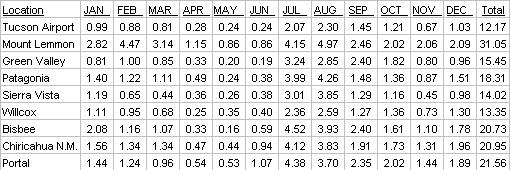What's the weather like in Arizona? (or more accurately, climate...)
Here we have given a basic representation of Arizona weather based on climate data from the last half of the century. Because the last 10 years have included some of the warmest years on record (globally), you should take the exact temperatures "with a grain of salt."
Also bear in mind that birding at higher elevations will bring much relief from the warmest temperatures in the summer. On average, for every 1000 feet you gain in elevation, temperatures drop ~4 degrees Farenheit. (Tucson = 2500'; Sierra Vista = 4600'; Willcox = 4150'; Bisbee = 5500', south exposure; Portal = 4800', north exposure.)
Monthly temperature averages across SE AZ (in degrees Farenheit)
Courtesy National Weather Service - Tucson
Monthly rainfall averages across SE AZ (in inches)
Courtesy National Weather Service - Tucson
Map of Arizona's annual precipitation (may be hard to read on some computers):
http://www.wrh.noaa.gov/images/twc/climate/az.jpg
How much daylight (or moonlight) will I have for birding?
Rather than giving you a limited amount of data, we prefer to give you the tools to calculate Sun and Moon data yourself. Simply follow any of the links described below. On that page, scroll down just a little bit and you will see search boxes for:
1) Year
2) Type of table desired (sunrise/set, moonrise/set, civil twilight, etc)
3) State or Territory
4) City or Town
Tip: Tucson or Sierra Vista are good major towns to use. Small Arizona towns are not typically listed.
The search results are fairly easy to read: month appears in the top column; date appears in the side column. And, it all prints out in one easy black/white page. Now you are equipped to search for this info anywhere in the world where you are planning a trip! (Glad we could help.)
Complete charts for sunrise/set, moonrise/set, civil twilight (U.S. Naval Observatory):
http://aa.usno.navy.mil/data/docs/RS_OneYear.php
For night birding (owls/nightjars), you can compare the above info against the percentage of the moon illuminated. A full moon tends to be better (full moon = 1.00 on the chart):
http://aa.usno.navy.mil/data/docs/MoonFraction.php
If you're a real nerd about this stuff (like us), go to the USNO home page and hover your mouse over "Data Services" (on the left):
http://aa.usno.navy.mil/


